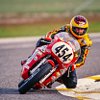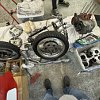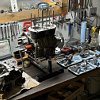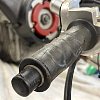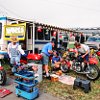Pennsylvania forest whizzed by as Zack slid open windows in the back of the school bus. I set my palms in my father’s handprints on the Honda’s grips and drove my weight down against the engine’s compression, offering a few degrees of throttle as my foot plummeted on the kickstarter.
The hollow sound of air moving lazily through cold cylinders. I kicked again, and a single bark shot from a reverse megaphone. Another few kicks and both cylinders fired, filling the bus with a sharp staccato and sending a shiver through my entire body.
It ran. This incredible mission might just work.
The “mission” entailed recovering my father Todd Henning’s crashed Drixton 450 race bike from New Hampshire, rebuilding it, and putting it on track at the Barber Vintage Festival in Birmingham, Alabama, as a tribute to dad and his racing career. It was a goal I’d had for years — made more urgent by the loss of my parents' home in 2023 — but hadn’t attempted to pull off because it was too difficult and too emotionally charged. I didn’t think I was up for it.
Mercifully, I wasn’t going it alone. Just as my father’s outsized racing efforts relied on a dedicated team of friends and supporters, I had Zack, Spenser, Spurgeon, and others helping make this dream a reality by shouldering the physical work and psychic load. By bringing the enigmatic energy of a CTXP production (coming tomorrow) to bear on the project, we’d accomplished in days what should have taken weeks. And now here we were, barreling down I-81 en route to Barber with a running motorcycle in the back of an old yellow school bus.

The last time the Drixton 450 started was April 18, 1999, when my father gridded up for AHRMA’s Premier 500 class. Five laps later the bike stalled — dad always set his carb slides to close fully when the throttle was released — in a cloud of dust on the outside of Turn 4.
I’ve alluded to my father’s accident before. He didn’t die that day, but the person he had been did. Grieving someone you’ve lost to a brain injury is confusing and continual; how do you mourn a loved one who’s still alive but is a different person? It’s something I’ve been trying to process for most of my life.
Much of that journey has involved learning about who my father was. It began with conversations with dad that I recorded in 2004, when I was 19. The glimpses seen through his damaged memories compelled me to ride my Suzuki Bandit 600 from Massachusetts to the Florida Keys, seeking out dad’s childhood friends, neighbors, employers, competitors, and others who could add texture to his story. Motorcycles were a throughline, and that was the thread I kept tugging at, because like dad, bikes ignite something inside of me.

Over the years I’ve continued to explore the experiences that molded dad into who he was, but I always backed away when it came to the accident. It felt too painful to examine. But I’d come to realize that it was also painful to leave unresolved.
You have to feel to heal, and boy were there a lot of feelings as I dove headlong into this project. I combed through technical drawings and machinists’ invoices to learn about the many modifications made to the bike, and dug up old magazine articles that discussed the Drixton and the success dad had with it. With the help of Zack and other friends, period racing footage was unearthed. Career photographers graciously searched through negatives to provide previously unseen images of dad racing and wrenching in the pits.

Finally, I summoned the courage to seek out the rider who had hit dad after he fell, to finally get an explanation, racer to racer, of exactly what happened. The conversation faltered several times as we both wept. I’d dipped my toe into the grief-filled pool of the past many times before, but now I was submerged in it. It hurt, but the pain brought a measure of release.
Arriving in New Hampshire, and finally laying eyes and hands on the pieces of dad’s race bike, made the ground beneath my feet feel shaky. The Drixton 450 is the culmination of dad’s legendary determination and represents the pinnacle of his racing career. It’s also the very motorcycle that took the dynamic and seemingly unstoppable Todd Henning away from us.
In many ways it was fitting that we had to assemble the machine, which had been taken apart decades ago in preparation for restoration. For starters, I felt I needed to earn the right to ride the bike, and putting it together, using the innate mechanical skills I inherited from dad, checked that box. Second, it provided an opportunity to study the components and glean precious details about how my father had developed the Drixton into a race-winning weapon. As Zack so accurately said at one point, “it’s pure archaeology."
Some clues required interpretation, while others were literal. The engine had notes written on it for valve lash, engine rev limit, oil quantity, bolt torques, and wiring for the ignition system, among other things. It wasn’t uncommon for dad to write reminders directly on items, but these tips were especially prescient given our compressed timeline and lack of familiarity with the machine. Did dad leave them for himself? A future self? For me?

Two aspects of the motorcycle were especially difficult to approach. First were the grips, an outmoded design that you heated and then squeezed, so the rubber molded to your hands. They presented dad’s complete handprints, palm to fingertips. They were a tangible, visceral, personal connection to the past. When I was eventually ready to touch them, it was to wipe them with a damp cloth, as if performing a taharah.
Then there were the tires, which I knew would show signs of the slide that took dad down. My own experience on the track told me what to look for, and there they were, the steeply angled streaks along the right shoulder of the rear Avon. The rest of the crash damage had been repaired — dents in the aluminum tank removed, frame powdercoated, bodywork replaced or repainted — but this evidence remained, and was unmistakable.
Assembly continued while we were on the road to Barber, with Spurg piloting the borrowed bus and Zack perched on the wheel well on the other side of the bike. Spenser and Andrew documented everything, including that fateful kick that brought the Drixton back to life after all these years. Once the engine fired, I could finally start to think about riding the bike.
After all the emotion, the hard work, and the stress, it was a tremendous relief to let muscle memory take over and ride. Racing is the most powerful connection I have with dad. Like wrenching, it’s something we’re wired to do, and piloting his Drixton 450 at speed, fully immersed in the moment and one with the machine, was like a mind meld across time.

Dad was there at Barber, smiling, encouraging, but quieter than usual. He’s an old man now, and has lived a third of his life with his brain injured. At one point I asked if he wanted to sit on his Drixton, and he replied with barely perceptible “no.” I don’t blame him.
Recovering, rebuilding, and racing the Drixton 450 has helped transport me through my grief. What happened to my father is tragic, but being able to honor him and memorialize his success is cathartic. The fact that the experience was documented in exceptional CTXP style, and the bike is now on display in the Barber museum for others to see and appreciate, is more than I could have ever hoped for.

It was an incredible mission, and with the help of my teammates at RevZilla, it was a resounding success.








